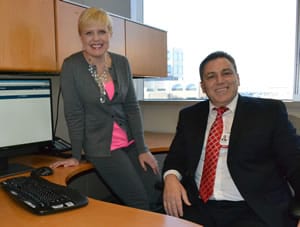
Tools should make life easier, and that applies to the tools researchers use accessing the Arkansas clinical Data Repository (AR-CDR), formerly the UAMS Enterprise Data Warehouse.
The AR-CDR has been a pillar of UAMS’ translational research infrastructure since its establishment in 2011 with support from the Translational Research Institute (TRI).
In 2015, UAMS leadership made improving researcher access to the AR-CDR a priority with the creation of the AR-CDR work group, led by Charlotte Hobbs, M.D., Ph.D., executive associate dean for research in the College of Medicine. The work group also included representatives from UAMS Information Technology, TRI, and the Department of Biomedical Informatics.
TRI, through its Clinical and Translational Science Award (CTSA) Consortium activities, discovered TriNetX, a federated clinical data network of providers, including pharmaceutical companies and contract research organizations (CROs), as well as 21 CTSA institutions. TriNetX presented to the work group, and TRI Director Laura James, M.D., and TRI Executive Program Manager Amy Jo Jenkins, M.S., led the effort to make UAMS part of the federated network, integrating it with the AR-CDR.
Jenkins organized an onboarding team of 16 people from TRI, the Department of Biomedical Informatics and UAMS Information Technology for acquiring and installing the network’s cohort estimation tool, establishing a security protocol, and training. “The work of our interdepartmental team was phenomenal,” Jenkins said. “UAMS had the fastest onboarding in the network’s history.”
The collaboration began in September, providing all UAMS researchers with three significant benefits:
- It includes a user-friendly search tool for exploring the rich clinical data repository as a preliminary step in developing clinical research studies.
- It helps match investigators with industry sponsored clinical trials.
- It can link cohort data at multiple network sites in the future.
Another key change recommended by the work group is the addition of the AR-CDR’s first director, Ahmad Baghal, M.D., who joined UAMS in October.
Baghal predicts the new search engine, the UAMS Research Cohort Estimation Tool, will be popular with researchers.
“We now have an intuitive cohort estimation tool; anybody can learn to use it in 10 minutes,” he said.
Apples to Apples
The primary tool for research cohort identification has been i2b2 (Integrating Biology and the Bedside). While it remains a component of AR-CDR, it has moved to the background with the UAMS Research Cohort Estimation Tool offering a self-service capability that provides researchers with deidentified aggregates for a study cohort.
“A nice feature of the new cohort estimation tool is the future ability to expand a study cohort by including other collaborating institutions in a query search. The good thing about the tool is that data received from different institutions are mapped to a single, unified ontology,” Baghal said.
Trial Run
Brad Martin, Ph.D., Pharm.D., gave the new system a trial run and came away impressed.
“Comparing the new query tool to the previous platform, i2b2, is kind of like comparing Windows to DOS,” said Martin, a professor in the UAMS College of Pharmacy. “The cohort estimation tool allows for an intuitive approach to understanding patterns in the data warehouse. One of the most impressive features of the new platform is that it allows users to build temporality into the queries. For example, users can build queries that require a diagnosis before some drug exposure or vice versa, which is critical for research and quality improvement analyses.”
The information researchers gather from their cohort estimation queries will help them determine whether to pursue additional, identifying data elements (e.g., demographics, procedures and diagnoses). To receive the identifiable data, researchers must seek IRB approval and submit a data request using the Request Services portal button on the TRI website (tri.uams.edu).
Additional information is also on the TRI website, including an online training tutorial. The Arkansas Clinical Data Repository (AR-CDR) page is in the main menu under Services, or simply type AR-CDR in the search field to find it.
In addition, Baghal will meet with research groups for more specialized training.
New Clinical Trial Opportunities
Another powerful feature of UAMS’ membership in the federated network is the abundance of new prospects for UAMS participation in industry sponsored clinical trials. The network serves as a matchmaker, helping the pharmaceutical industry identify researchers to conduct clinical trials.
“As members of the network, there are mutually beneficial opportunities for our researchers and the pharmaceutical industry looking for collaborators,” James said.
Jenkins has served as the liaison to industry sponsors looking for sites to run their clinical trials. After receiving an inquiry, she attempts to find an interested investigator through the UAMS Service Line research liaisons or the Rockefeller Cancer Institute. She facilitates the required confidentiality agreements and works with the sponsor to get their trial placed at UAMS.
Since becoming part of the network, UAMS has received 22 inquiries about clinical trial opportunities. UAMS faculty are pursuing clinical trials in stem cell transplantation, cytomegalovirus infection, pain management, irritable bowel disease, renal disease, diabetes and prostate cancer.
“The network collaboration is helping UAMS faculty be at the front end of clinical trial opportunities as trials are being rolled out from pharmaceutical sponsors,” James said. “It increases our visibility to the broader research industry, and that’s good for UAMS and our patients.”
